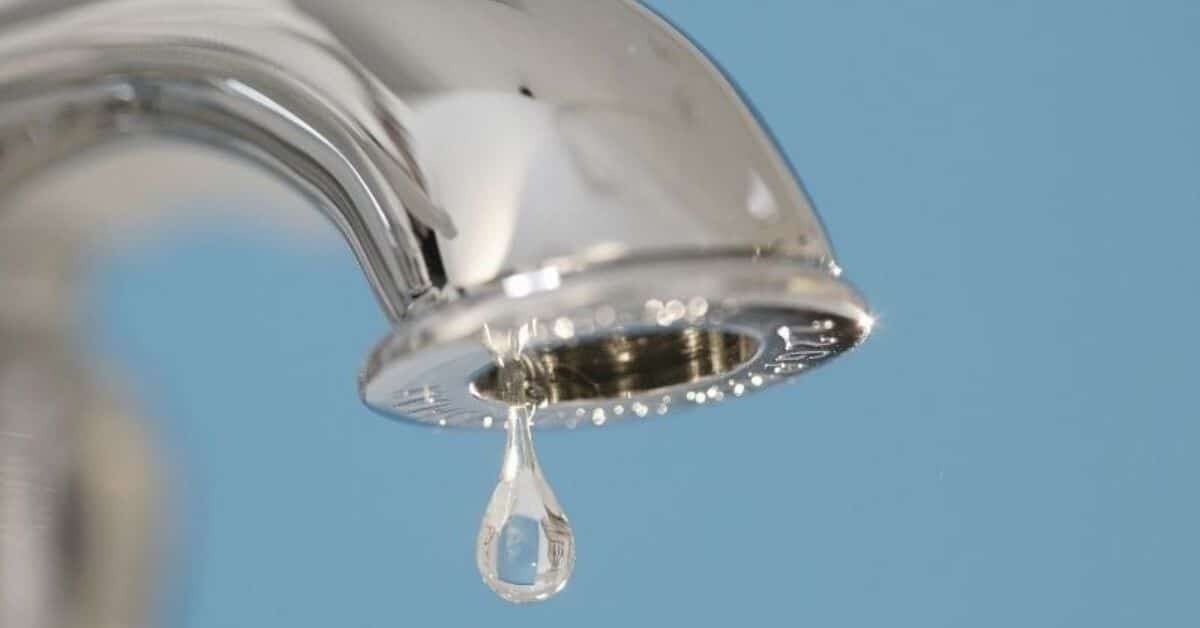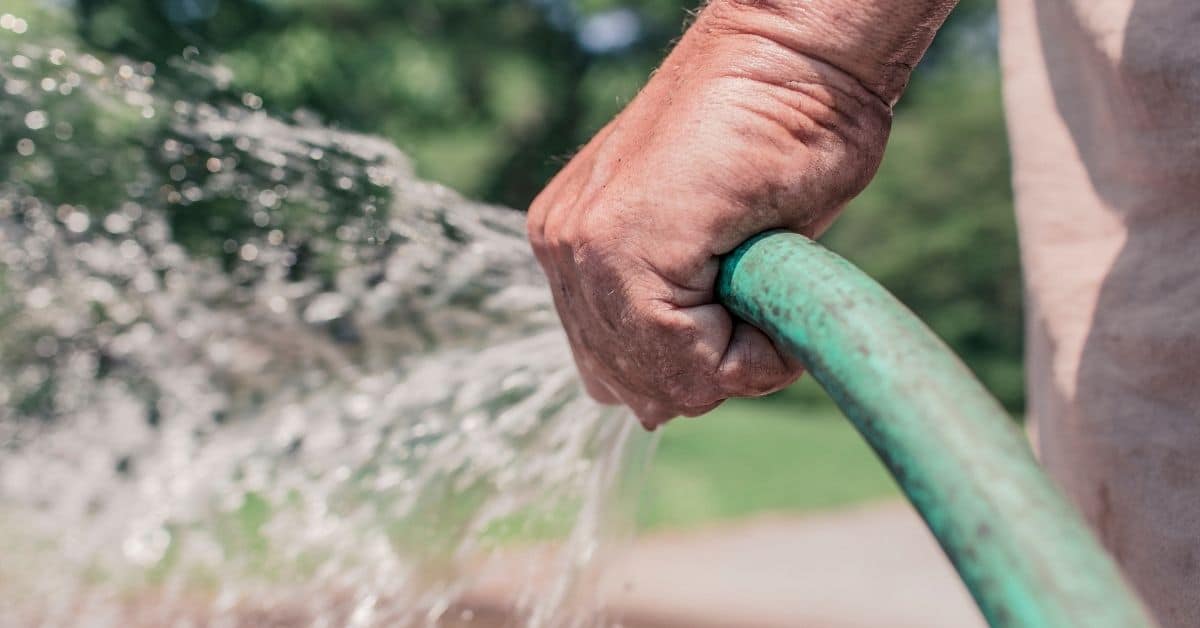Indoor water conservation tips are bountiful, easy, and mostly free. Even better, they can be practiced year-round in the home. Here are some tips to conserve indoor water that will lower your water bill and your eco footprint leaving you feeling good on your sustainable lifestyle pursuit.
Like this? Share it with others!
This post contains affiliate links. My preference is to provide links to companies other than Amazon whenever possible. I recognize many people like Amazon, not to mention there are eco-friendly, ethical, and sustainable brands out there who use Amazon. I want to support them. So, just know you may see multiple links for one option. Should you make a purchase through these links, I will receive a small commission at NO additional cost to you. See my Disclaimers & Disclosures and Privacy Policy for more information.
Reasons to Conserve Water?
The average U.S. family uses over 300 gallons of water per day – 70% of that from indoor use. That’s a lot of water. See how the EPA breaks down how that indoor water is used:
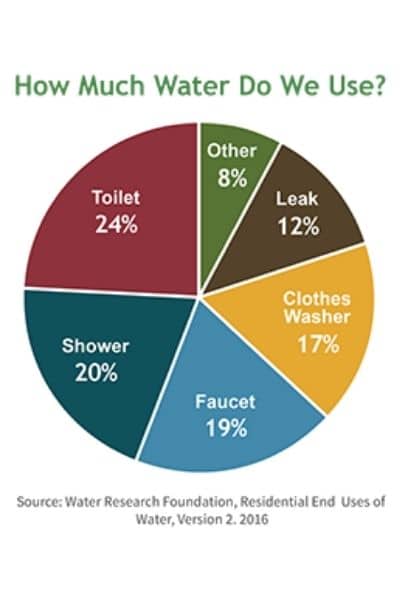
Fresh water is a finite resource, which means less than 1% of water on Earth is suitable for human use. Thus, fresh water is arguably our most precious resource. We cannot live without it.
So, yes, conserving water on a daily basis is a huge component on living a sustainable lifestyle.
To help you live more sustainably, below are several (27 in fact) ways to conserve water indoors you’ll find easy to implement into your lifestyle that will also save you money on your water bill.
Kitchen Conserving Water Tips
1 – Turn Faucet Off When Not Using Water
This is a biggie. And it’s the easiest and free way to conserve indoor water. Remember, 19% of indoor water use comes from the faucet.
Quite simply, if you are not running anything under the water, turn off the faucet. Only perform actions that require water, like washing dishes, hands or produce, with the water running.
When washing dishes, use a bin or sink section for washing only and collect dishes to the side until you’re ready to rinse them; or, use another bin of fresh water for rinsing only. This can save gallons of water every day. If you don’t believe me, put a bin underneath your faucet and see how much water you collect from water you’re not really using.
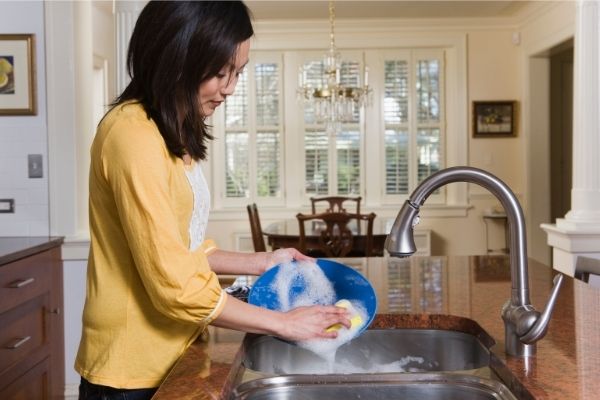
2 – Scrape and Soak Dishes
Don’t automatically reach for the garbage disposal. Scrape all food into your compost bin, to reduce food waste, first.
If you have tough food removal ahead, try soaking the dishes in a little water so the food can loosen before you wash them by hand.
If you have an energy efficient dishwasher, there’s no need to pre-soak. Just wash them, or use the rinse feature once first, and the dishwasher and eco-friendly dishwasher detergent will do the rest of the work.
3 – Reuse Water
When rinsing produce, collect the water with a bowl or small bin and use that water to water plants or garden, or use for outdoor cleaning.
Same for boiled water. Did you steam your veggies on the stove? Reuse the water instead of throwing it out.
4 – Keep Water Cool
If you like your drinking water cold, keep the water container in the refrigerator. It saves you from needlessly running water for it to get cold for drinking.
You’ll Also Like
5- Install a Kitchen Faucet Aerator
Faucet aerators reduce the flow of water without sacrificing water pressure. The average flow rate of a kitchen faucet is 2.2 gallons per minute (gpm), so a 1 gpm faucet aerator can save up to 50% in water. Better yet, most aerators cost under $10.
6 – Use a Water Efficient Kitchen Faucet
If you don’t want to go the aerator route, upgrade to a WaterSense kitchen faucet. If you do not get a WaterSense certified kitchen faucet, any faucet that saves 20% or more than a 2.2 gpm faucet is going to save you water and money.
Check out the Plumbing Fixtures section of the CORR Concepts Conscious Consumer Directory. It will point you in the right direction to find WaterSense or equivalent kitchen faucets.
7 – Fix Water Leaks
It’s a good idea to regularly look around your kitchen plumbing and appliances for leaks. Even little leaks can add up to hundreds of gallons of water lost every year.
Not only will water issues be diverted, protecting your home, but you’ll also be able to identify where you can save water.
If you’re not handy, hire a plumber to do the fixing. It’s worth the money in the long run.
8 – Fill Up the Dishwasher
Make the most out of your dishwasher and only run it when it’s full and adjust the water-level settings for the most efficiency to save water and energy – double money savings.
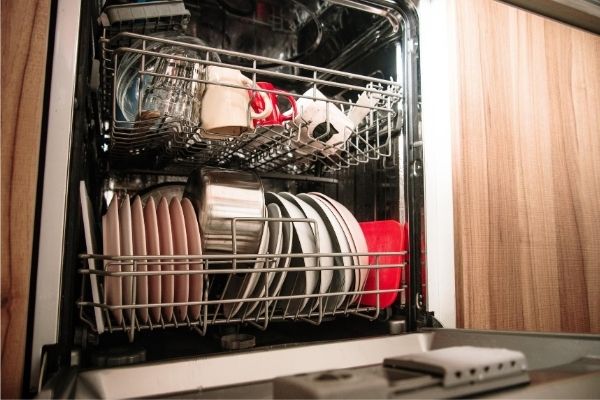
9- Upgrade to ENERGY STAR
An ENERGY STAR certified dishwasher will save, on average, 3,870 gallons of water over its lifetime. If you’re the market for a new dishwasher, make sure it’s ENERGY STAR certified.
Again, the Conscious Consumer Directory can point you in the right direction on brands to shop and where.
Bathroom Conserving Water Tips
10 – Turn It Off When Not in Use
What goes for the kitchen, goes for the bathroom: only run the bathroom fixtures when needed. It’s easy and free to implement.
Turn the faucet water off when brushing your teeth or shaving. If need be, fill up the sink with a little water to rinse off your razor.
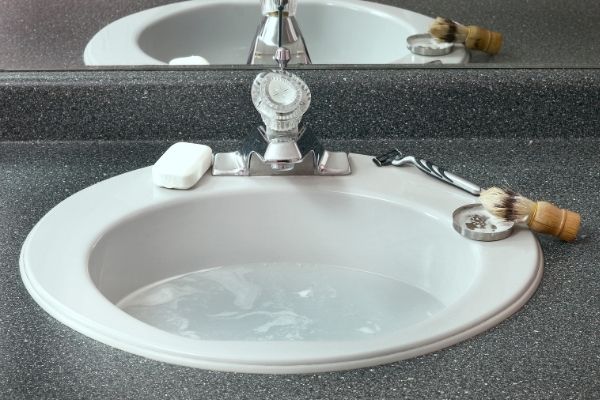
In the shower, turn the water on only to rinse wet down and rinse off.
CORR Tip
To save more water, put a bucket under the shower head while the water is heating up so you can use that water elsewhere.
11 – Install Bathroom Faucet Aerators
Faucet aerators work great in the bathroom, too. The average flow rate of a bathroom faucet is also 2.2 gpm, so a 1 gpm aerator can save you additional 50% of water use in each bathroom an aerator is installed.
12 – Take 5 Minute Showers
Ultimately, this means not letting the shower water run for more than 5 minutes total. Combined with the tip above, you can make your shower time last longer than 5 minutes.
Purchase a shower timer to help. They are inexpensive.
13 – Use a WaterSense Bathroom Faucet
There are a multitude of stylish, WaterSense certified bathroom faucets to choose from. The WaterSense label certifies the faucet will reduce water flow by a minimum of 30% beyond the 2.2 gpm average, saving the average U.S. family hundreds of gallons of water every year.
Find out where to start looking for your WaterSense bathroom faucet.
14 – Install a WaterSense Showerhead
Like the bathroom faucet, the WaterSense label can also be found on showerheads.
The average flow rate of a residential showerhead is 2.5 gpm, and a WaterSense showerhead uses a maximum of 2 gpm, a 20% savings.
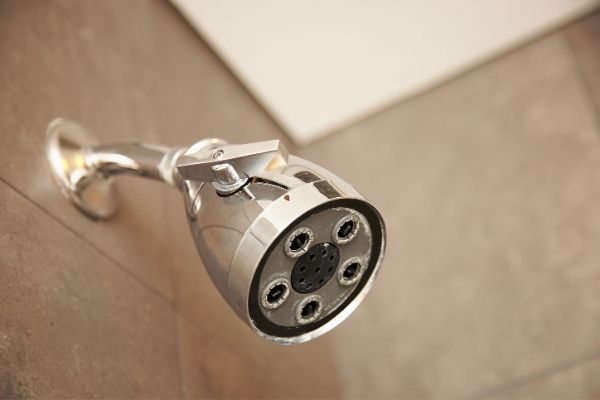
15 – Flush Less
Remember the EPA chart above? The residential toilet accounts for 24% of water use at home. That’s a large chunk of daily water usage!
I’m sure you’ve heard the saying, “If it’s yellow, let it mellow. If it’s brown, flush it down.” Well, implementing this saying into your daily lifestyle can give huge savings on water by avoiding flushing the toilet unnecessarily.
16 – Install a WaterSense Toilet
The federal standard water flow for a residential toilet is 1.6 gallons per flush (gpf). A WaterSense toilet is guaranteed to use 20% less than the standard toilet, at minimum.
Toilets are fairly inexpensive, especially when you combine the future water and money savings. Upgrading your toilet to a maximum 1.28 gpf toilet can save, on average, 13,000 gallons of water every year and over $2000 over the lifetime of the toilet.
Go even further, and upgrade to a dual-flush toilet. A 1.1 / 1.28 gpf dual-flush toilet will add more water and financial savings.
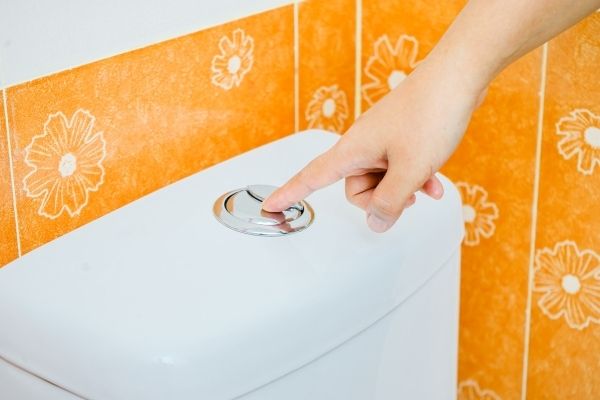
17 – Use a Toilet Water Displacement Device
Can’t afford the new toilet up-front costs just yet? Consider a work-around to save indoor water by installing a displacement device, like a bottle or tank insert, in the toilet tank to reduce the amount of water used for each flush.
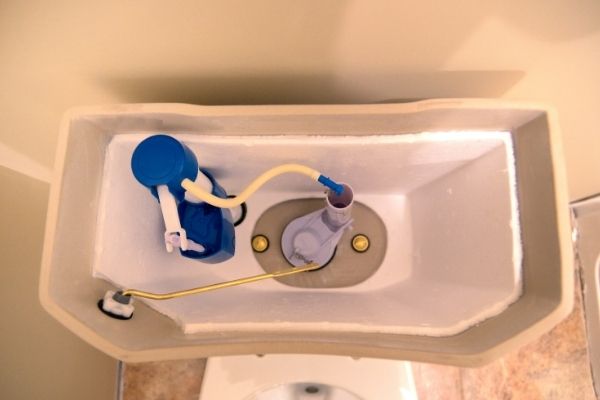
18 – Fix Bathroom Water Leaks
Like the kitchen, do regular checks around your bathroom sinks, toilets, tubs and shower heads.
Drop a couple of non-toxic, toilet leak detection dye tablets into your toilet tank, let sit 15 minutes, and then flush to see if your toilet is leaking.
Many small bathroom leaks can be repaired by replacing a washer or sealing, or simply upgrade to a more efficient plumbing fixture.
19 – Install a Tankless Water Heater
You don’t just use more energy heating up your water, you waste water that way as well.
Consider swapping out your water heater for a tankless water heater that heats water on demand.
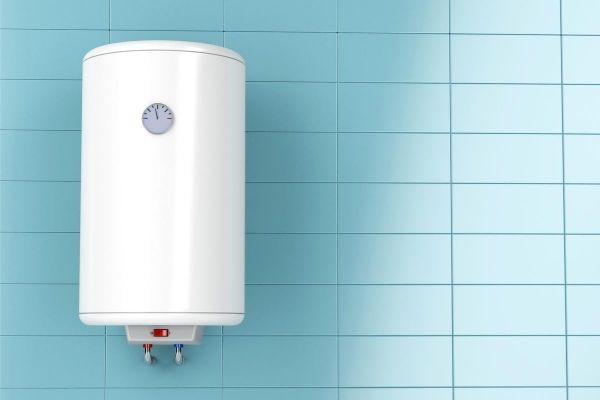
Laundry Conserving Water Tips
20 – Check for Appliance Leaks
Yep, this goes for the clothes washer and utility sink, too.
21 – Fill Up the Clothes Washer
Like the dishwasher, run the washing machine only when you have a full load. In a pinch, use the machine’s lower water level settings to match your smaller loads.
Run the clothes washer at shortest settings and with cold water only also helps conserve indoor water.
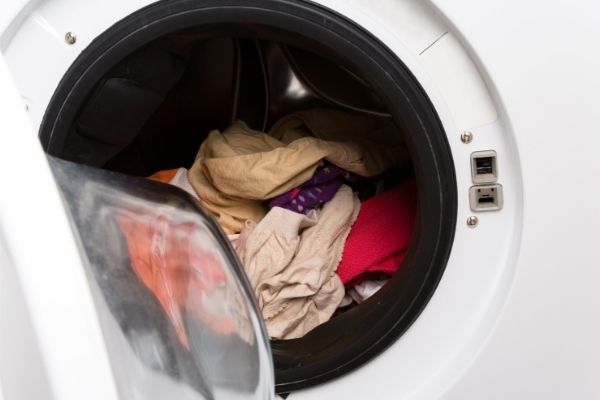
22 – Upgrade to ENERGY STAR
An ENERGY STAR certified clothes washing machine saves about 6 gallons less per load compared to a standard machinefor an average $185 a year financial savings.
Review the Conscious Consumer Directory for certified brands when you’re ready to upgrade to ENERGY STAR.
Additional Indoor Water Saving Tips
23 – Reuse Dehumidifier Water
The next time you empty the dehumidifier, don’t throw the water out. Use it to water your plants or for cleaning.
24 – Insulate Water Pipes
Quick and inexpensive, insulating your water pipes with foam pipe insulation makes pipes hold hot water longer avoiding the need to run more water for heating up.
25 – Avoid Water Emergencies
Know where your water master shut-off valve is to avoid potential flooding and home damage.
26 – Know Your Water Bill
Before you implement any of the above water conservation techniques, review your past 12 months’ water bills. Knowing what months show the highest water usage helps target areas you can improve.
Ask your municipality if they provide a water audit for your home. They can provide tips targeted for your area.
27 – Be Water Conscious Creative
Look around your home and review your daily habits on additional ways you think you can conserve indoor water yearly. No act is too little, and it all adds up to big savings.
Don’t be afraid to share water-saving ideas, or this post, with your friends, family and neighbors. If you find another way to conserve indoor water, share with the rest of the class and post a comment below.
Let Me Hear From You
I would love to hear if any of these ways to conserve indoor water at home were helpful to you. Post me your thoughts or questions in the Comments section below. Thank you!
Like this? Share it with others!
MORE WATER CONSERVATION POSTS YOU’LL LIKE
29 Ways to Conserve Water Outdoors

Gwen, CORR Concepts Founder
Gwen is a Sustainability professional with an MBA in Sustainable Enterprises and LEED AP ID+C accreditation from the GBCI. She is also the Founder of CORR Travel. As a Sustainability professional and Earth Steward, environmental sustainability and biodiversity protection is her “religion”. Travel is her passion.

